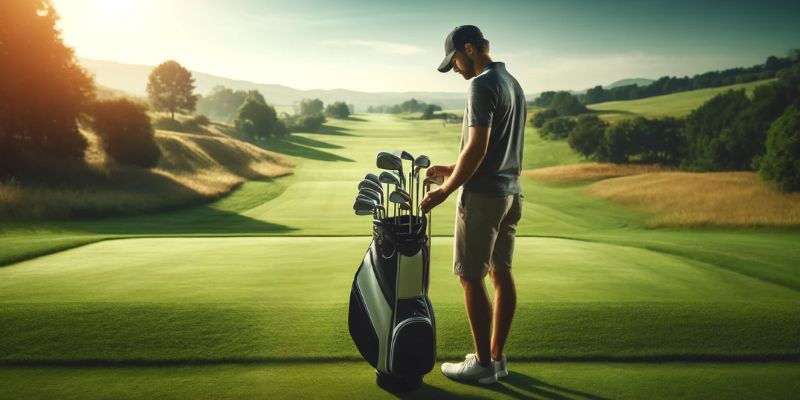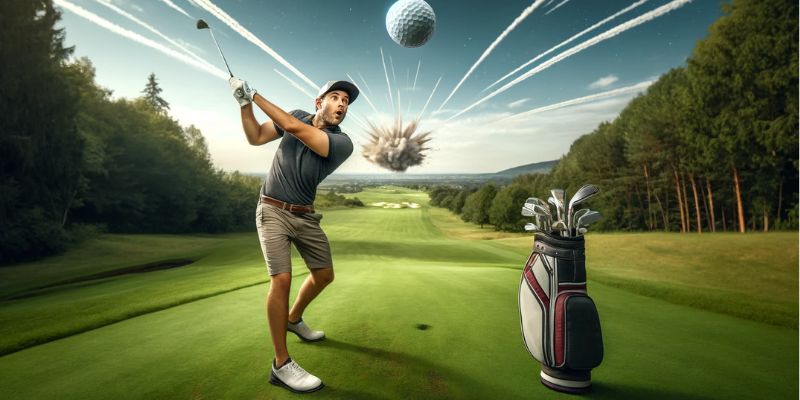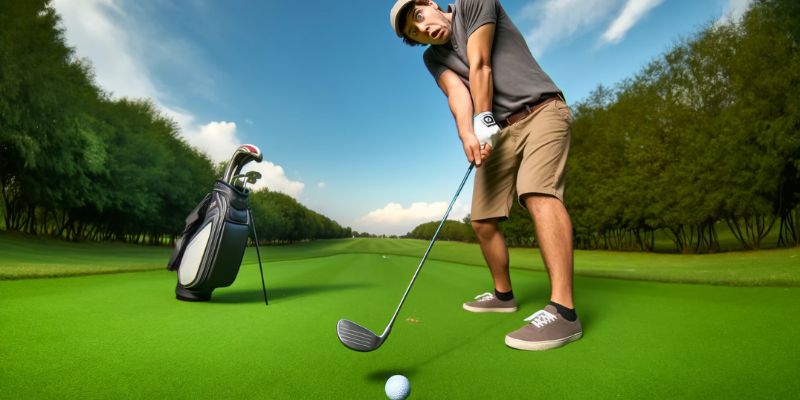
Transitioning from Cavity Back to Blade Irons
Introduction: Navigating the Evolution of Golf Irons – Cavity Back vs. Blade
Golf irons have undergone significant transformations over the decades, evolving from simple, bladed designs to the highly engineered cavity back and blade options available today. This evolution reflects not only advancements in technology but also a deeper understanding of golfer needs across different skill levels. The debate between cavity back and blade irons continues to be a central topic among golfers, with each type offering distinct advantages and challenges.
Choosing the right type of iron to put in your golf bag is crucial as it can dramatically influence your game. The decision should align with your current skill level, playing style, and game improvement goals. While cavity-back golf irons are renowned for their forgiveness on off-center hits, making them ideal for beginners and intermediate players, blade irons are favored by more experienced golfers for their control and feedback, crucial for refining shot precision.
Understanding Golf Iron Types
What Are Blade Irons?
Blade irons, often referred to as “muscle-backs,” are characterized by their thin, sleek design with most of the weight concentrated along the back of the club. This design offers a smaller sweet spot but provides greater control and feedback, allowing skilled players to execute a wide range of shots with precision. Blade irons are typically forged from a single piece of metal, which contributes to their softer feel at impact—a quality highly valued by advanced golfers.
Difference Between Cavity Back and Blade Irons
Design Features:
- Cavity Back Irons: These irons feature a hollowed-out back, distributing weight around the perimeter of the club head. This design enhances forgiveness and increases the sweet spot size, making them more user-friendly for those who do not consistently hit the center of the clubface.
- Blade Irons: Blade irons have a full back on the club head, with weight distribution that is more uniform across the face but concentrated toward the center. This setup demands greater precision but offers superior feedback and control.
Benefits:
- Cavity Back Irons: The main benefit of cavity back irons is their ability to reduce the negative effects of mis-hits. They are generally easier to play with and can help improve confidence for less experienced golfers.
- Blade Irons: Blades excel in providing feedback, which helps better players adjust their swing mechanics and improve their accuracy. They also allow for easier manipulation of ball flight, crucial in strategic shot making.
Typical User Profiles:
- Cavity Back Irons: Ideal for beginners, high handicappers, seniors, and mid-handicappers who benefit from extra forgiveness and help with getting the ball airborne. These irons are particularly useful for players who need assistance in their swing to achieve distance and accuracy.
- Blade Irons: Best suited for low handicappers, professional golfers, and skilled senior players who demand precision and the ability to shape shots on demand. These irons cater to those who have refined their technique and seek greater control over their game outcomes.
Understanding the key differences between cavity back and blade irons is the first step in selecting the right tools to match your skills and enhance your performance on the golf course. Whether you’re looking to improve your accuracy or need a more forgiving club, the choice between these iron types will significantly impact your game development and enjoyment.
Why Make the Switch?
Switching to blade irons is a significant step in a golfer’s journey, often reflecting an advancement in skill level and an increased commitment to refining their game. Understanding the benefits and determining the ideal timing for such a transition are crucial for making the most out of this change.
Benefits of Playing with Blade Irons
- Enhanced Feedback: Blade irons are highly regarded for their ability to provide immediate and precise feedback on each shot. This means that a golfer can feel exactly where the ball strikes the club face, helping to identify mishits more clearly. Such feedback is invaluable for players looking to refine their swing and improve their precision.
- Greater Control and Precision: Due to their design, blade irons allow for more control over ball trajectory and spin. The concentrated weight distribution in blade irons offers experienced players the ability to execute more controlled shots with greater accuracy. This control is particularly beneficial in situations requiring complex shot shapes or when playing on courses with challenging layouts.
- Superior Shot Shaping: Blades are the preferred choice for players who like to shape their shots—drawing or fading the ball on command. The minimal offset and smaller club head allow skilled golfers to manipulate the ball flight more effectively, a crucial aspect in competitive play where adaptability to various course conditions is key.
Challenges and Considerations
Switching to blade irons can significantly enhance a golfer’s game, but it also presents certain challenges that require careful consideration. Understanding these difficulties and assessing readiness are critical steps before making the transition.
Difficulties of Using Blade Irons
- Smaller Sweet Spot: One of the main reasons blade irons are harder to hit is their smaller sweet spot. Unlike cavity backs, which are designed to maximize forgiveness, blades require more precise contact with the ball. This precision demands consistent swing mechanics, as even slight mishits can result in significantly poorer outcomes.
- Increased Feedback: While the enhanced feedback from blade irons is beneficial for improving your game, it can also highlight flaws in your swing more starkly. This means that any imperfections in your swing technique will be more noticeable, potentially leading to frustration during the adjustment period.
- Less Forgiveness: Blade irons are less forgiving on off-center hits compared to cavity back irons. This lack of forgiveness can affect distance and accuracy, making it particularly challenging for those who do not consistently strike the ball well.
Assessing Readiness for Transition
- Consistency in Ball Striking: Before switching to blade irons, ensure that your ball striking is consistently solid. This means regularly hitting near the center of the clubface with your current irons.
- Handicap Consideration: Many golf professionals recommend that golfers should consider switching to blade irons if they have a single-digit handicap, as this typically indicates a higher skill level and better control over shot-making.
- Comfort with Current Skill Level: Evaluate whether you feel comfortable and confident with your current irons. If you’re frequently making good contact and looking for more control and feedback to improve your game further, it might be time to consider blades.
Practical Transition Tips
Tips for Transitioning to Blade Irons
- Start with a Mixed Set: If you’re not ready to switch entirely to blade irons, consider starting with a mixed set. Use blades for your shorter irons where precision is more crucial, and cavity backs for your longer irons where forgiveness is beneficial.
- Practice Routines: Integrate specific practice routines focusing on hitting blade irons. Begin with short, controlled swings to build confidence and gradually increase the length and speed of your swings as you become more comfortable.
- Use of Feedback: Pay close attention to the feedback from blade irons during practice sessions. Use this information to adjust your swing technique and alignment. The immediate feedback when hitting blades is invaluable for identifying and correcting swing faults.
Improving Precision and Feedback
- Focused Practice on Feedback: Utilize the feedback from blade irons by practicing on different types of lies and course conditions. This will help you understand how slight changes in swing path and face angle impact your shots.
- Recording and Analyzing: Consider recording your practice sessions to visually analyze your swing and its impact on ball flight. This can be particularly helpful when adjusting to the precision required by blade irons.
- Regular Check-ins with a Coach: Work regularly with a golf coach to ensure your transition to blade irons is progressing well. A coach can provide immediate corrections and adjustments, helping you make the most out of the feedback provided by blade irons.
Transitioning to blade irons is a significant step in any golfer’s journey. By understanding the challenges, assessing your readiness, and applying practical tips for a smooth transition, you can enhance your performance and enjoy the sophisticated playstyle offered by blade irons.
Selecting the Right Blade Irons
Choosing the right blade irons is a crucial decision that can significantly impact your golfing experience. Here are key factors to consider, ensuring that your selection not only matches your current skill level but also supports your growth in the sport.
How to Choose Blade Irons for Different Skill Levels
When selecting blade irons, consider several critical factors that can affect performance:
- Clubhead Design: Look for a clubhead that provides the level of control and feedback you need. Blade irons typically have smaller clubheads that offer better shot shaping capabilities but require more precise ball striking.
- Shaft Stiffness: The stiffness of the shaft plays a crucial role in how well you can control your shots and the kind of feedback you receive. Stiffer shafts generally offer more accuracy for those with faster swing speeds, while more flexible shafts can benefit players with slower swings.
- Overall Weight: The weight of the iron affects your swing tempo and stability. Heavier irons can offer more control, but they require stronger swings, so make sure the weight complements your physical capabilities and swing style.
Best Blade Irons for Beginners and Low Handicappers
For beginners transitioning to blade irons, it’s essential to start with models that are somewhat forgiving yet allow for skill advancement. For low handicappers, the focus should be on irons that provide enhanced control and feedback. Here are a few recommendations:
-
Beginners:
- Titleist T100s: Known for combining playability with forgiveness, these irons can be a good starter set for those new to blades.
- Callaway Apex Pro: These irons offer a good balance of forgiveness and the benefits typical of blade designs, making them suitable for beginners wanting to make the transition.
-
Low Handicappers:
- Mizuno MP-20: Celebrated for their feel and precision, these blades are ideal for low handicappers who demand meticulous control over their shot shaping.
- TaylorMade P7MB: Designed for high-level play, these irons offer exceptional feedback and control, suited for skilled players refining their game.
Advanced Considerations
Club Fitting for Blade Irons
Getting custom-fitted for blade irons cannot be overstated in importance. A professional fitting session will help ensure that your irons are tailored to your specific swing metrics, such as speed, launch angle, and spin rates. Custom fittings can adjust the lie angle, loft, and shaft type, which are all crucial for maximizing the performance benefits of blade irons.
Continued Learning and Adaptation
Transitioning to blade irons is just the beginning. Continued improvement and adaptation are key:
- Take Lessons: Regular lessons with a golf pro can accelerate your adaptation to blade irons. A professional can provide immediate feedback and guidance on adjusting your technique to better suit your new irons.
- Practice Diligently: Spend ample time on the range practicing with your new blade irons. Focus on the feedback each shot provides to understand and refine your swing.
- Seek Professional Advice: Don’t hesitate to consult with more experienced players or club fitters. Their insights can provide valuable perspectives on making the most of your blade irons.
Choosing and using the right blade irons involves a combination of careful selection, professional fitting, and ongoing adaptation and learning. By considering these aspects, golfers of all skill levels can enhance their game, enjoying the precision and control that blade irons can offer.
Elevating Your Game with Blade Irons
Transitioning to blade irons is a significant decision that can profoundly impact your golfing experience. Throughout this article, we’ve explored the distinctive features of blade irons, the advantages they offer in terms of feedback and control, and the considerations important for choosing the right set for your skill level and playing style.
Key Points Recap:
- Enhanced Control and Feedback: Blade irons provide superior feedback and control, allowing skilled players to execute more precise shots and refine their techniques on the course.
- Considerations for Transition: Before making the switch, it’s crucial to assess your current golfing skills and consistency. Blade irons demand precision and are best suited for players who are confident in their swing and ball-striking abilities.
- Choosing the Right Irons: Selecting the right blade irons involves considering factors such as clubhead design, shaft stiffness, and overall weight—elements that should match your physical capabilities and swing dynamics.
- Professional Fitting and Ongoing Learning: Custom fitting is essential to ensure blade irons are tailored to your specific needs, maximizing the benefits they can offer. Continued practice and possibly taking lessons are recommended to fully adapt to the nuances of playing with blade irons.
Switching to blade irons can dramatically elevate a golfer’s game by enhancing the precision and control available during play. However, this transition should not be taken lightly. Golfers considering blade irons should carefully evaluate their skills and needs. It’s advisable to consult with golf professionals who can provide guidance during the selection process and help integrate blade irons into your game effectively.
Whether you are a seasoned player looking to fine-tune your performance or an aspiring enthusiast eager to take your skills to the next level, blade irons offer a pathway to achieving greater mastery of your golf game. By embracing the challenges and opportunities that come with blade irons, you can unlock a new dimension of strategic play and personal achievement on the golf course.




